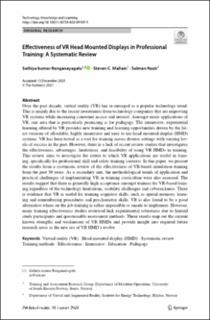| dc.contributor.author | Renganayagalu, Sathiya Kumar | |
| dc.contributor.author | Mallam, Steven | |
| dc.contributor.author | Nazir, Salman | |
| dc.date.accessioned | 2021-02-10T10:15:52Z | |
| dc.date.available | 2021-02-10T10:15:52Z | |
| dc.date.created | 2021-01-04T09:18:56Z | |
| dc.date.issued | 2021 | |
| dc.identifier.citation | Renganayagalu, S. k., Mallam, S. C. & Nazir, S. (2021). Effectiveness of VR Head Mounted Displays in Professional Training: A Systematic Review. Technology, Knowledge and Learning. | en_US |
| dc.identifier.issn | 2211-1662 | |
| dc.identifier.uri | https://hdl.handle.net/11250/2727131 | |
| dc.description.abstract | Over the past decade, virtual reality (VR) has re-emerged as a popular technology trend. This is mainly due to the recent investments from technology companies that are improving VR systems while increasing consumer access and interest. Amongst many applications of VR, one area that is particularly promising is for pedagogy. The immersive, experiential learning offered by VR provides new training and learning opportunities driven by the latest versions of affordable, highly immersive and easy to use head mounted display (HMD) systems. VR has been tested as a tool for training across diverse settings with varying levels of success in the past. However, there is a lack of recent review studies that investigates the effectiveness, advantages, limitations, and feasibility of using VR HMDs in training. This review aims to investigate the extent to which VR applications are useful in training, specifically for professional skill and safety training contexts. In this paper, we present the results from a systematic review of the effectiveness of VR-based simulation training from the past 30 years. As a secondary aim, the methodological trends of application and practical challenges of implementing VR in training curriculum were also assessed. The results suggest that there is generally high acceptance amongst trainees for VR-based training regardless of the technology limitations, usability challenges and cybersickness. There is evidence that VR is useful for training cognitive skills, such as spatial memory, learning and remembering procedures and psychomotor skills. VR is also found to be a good alternative where on the job training is either impossible or unsafe to implement. However, many training effectiveness studies reviewed lack experimental robustness due to limited study participants and questionable assessment methods. These results map out the current known strengths and weaknesses of VR HMDs and provide insight into required future research areas as the new era of VR HMD’s evolve. | en_US |
| dc.language.iso | eng | en_US |
| dc.rights | Navngivelse 4.0 Internasjonal | * |
| dc.rights.uri | http://creativecommons.org/licenses/by/4.0/deed.no | * |
| dc.title | Effectiveness of VR Head Mounted Displays in Professional Training: A Systematic Review | en_US |
| dc.type | Peer reviewed | en_US |
| dc.type | Journal article | en_US |
| dc.description.version | publishedVersion | en_US |
| dc.rights.holder | © The Author(s) 2021. | en_US |
| dc.source.journal | Technology, Knowledge and Learning | en_US |
| dc.identifier.doi | https://doi.org/10.1007/s10758-020-09489-9 | |
| dc.identifier.cristin | 1864523 | |
| dc.relation.project | Norges forskningsråd: 269424 | en_US |
| cristin.ispublished | true | |
| cristin.fulltext | original | |
| cristin.qualitycode | 2 | |

